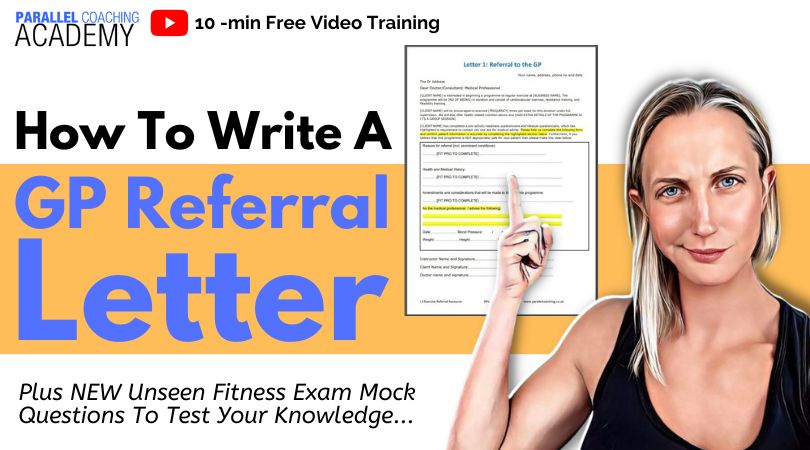As a Fitness Professional, you will need to write a GP Referral Letter at some point in your fitness career. This blog will leave you competent and confident to send a professional letter and liaise with medical professionals.
You’ll learn:
- 10 minute video tutorial
- The limitations of who you can work with as a FITPRO
- How to use the PARQ and PARQ-plus in your screening process
- The strategy to follow when sending a GP Referral Letter
- The Professional letter structure
- How to speed up the process and reduce the load on the Medical professional.
At the bottom of this blog, you’ll also find three mock questions to test your knowledge
Watch: How To Write A GP Referral Letter?
The limitations of who you can work with as a FITPRO
As a FITPRO there are limitations as to who you can work with. The foundation qualifications of Level 2 Gym, Level 3 Personal Trainer, Level 3 Pilates and Level 3 Yoga, only equip you to work with apparently healthy individuals.
These are the ones that pass a PAR-Q with “No” as the answer to all questions.
The client will also have no medical conditions or take medications.
If the client answers “YES” to the PAR-Q questions, has medical conditions or takes medications then you need to have further qualifications in order to work with them…
And yes that is still the case even if you have a signed GP letter, they can still only work with those that are qualified.
The qualification is called Level 3 Diploma in Supporting Clients With Long Term Conditions, or the old version is GP Referral or Exercise Referral
These qualifications explicitly explore a list of long-term conditions and state the considerations and contraindications for each condition. You learn how to adapt to exercise and manage the risk associated with the condition.
If you have this qualification already, then this blog is for you as you are then able to liaise with GPs and other medical professionals to share client progress data and verify that they are safe to exercise.
How to use the PARQ and PARQ-plus in your screening process
The PARQ (Pre-Activity Readiness Questionnaire) is a screening tool that should be used for every single client that you work with, whether that’s one-to-one or in a class. This form will highlight whether the client is safe to exercise. If they answer YES to any question then a GP referral letter is required.
However, if you know your client is going to refer a PARQ, based on your preliminary chat (and you are qualified to work with those that have conditions) it would be more appropriate to use the PAR-Q PLUS.
The PARQ-plus is designed as a screening and risk stratification tool for clients that refer a normal PARQ. This form asks additional sub-questions. If the answer to the sub-question is NO then you do not need to liaise with a GP (unless you have other reasons to do so).
If the client answers YES to any of the subquestions then you need to write a GP referral letter to find out more before deciding if the client is safe to exercise.
The strategy to follow when sending a GP Referral Letter
A referral letter can be sent to any medical and healthcare professional, so it is important to choose the best one for the client and their conditions. If your client is under a specialist consultant, for example, an oncologist, diabetic nurse, physiotherapist or cardiologist, then refer to them.
If your client isn’t supported by a specialist, then refer to their GP surgery.
Each medical professional has a different method of handling letters and communication, so don’t assume that a physical letter is best. Instead, phone the consultant or GP surgery and ask HOW they would like you to send the letter.
They may suggest a direct email address, or a physical address, r even via a specific Referral Portal.
it’s a simple step but will speed up the process and help strengthen the referral relationship.
The Professional letter structure
Whether you are sending an email or a physical letter, make sure that the letter is professional. This means that on the top right of the letter, you need to include your name, physical address, email address, and date. Then on the top left of the page include the Gp/ medical professional’s name and address.
Then start the letter with a heading like this “Re: John Smith DOB: 01/01/78”. This clearly indicates to the GP which client you are referring to.
You can then write a short concise intro explaining the purpose of the letter, and then include all the data you have about the client. Include their medical history, key measurements including blood pressure, the reason for referral, medications etc. Then add a section where you clearly explain what you will/ will not do with the client to help manage the risk of working with them alongside their conditions.
Then allow a short space for the medical professional to write a response about the client’s ability to take part.
Make sure you sign off the letter making it clear that you require a response and how to respond to you. Sign off the letter with a professional “Yours sincerely” signature and, seal the envelope with any return address made clear.
There’s a lot to think about here, so you can speed up the process by using our templates, which are part of FITPRO start-up kit, where you get 34+ documents and templates to help yo get started as a FITPRO, including risk stratification tools, PARQ, fitness questionnaires and GP referral letter templates.
https://courses.parallelcoaching.co.uk/products/fitpro-start-up-kit/

How to speed up the process and reduce the load on the Medical professional.
Make sure you keep the letter clear, short and concise. Include all of the relevant data and details but don’t expect the GP to write a lot. The shorter the information required by the GP, the more likely it is that they will be able to complete it quickly and without additional “overtime charges”.
By making communication as easy and professional as possible yo are much more likely to get more clients referred to you directly from the GP or medical professional in the future.
Test your knowledge with three mock questions:
[NOTE: The answers are below the 3rd question]
Q1: What is the best screening tool to use with a client your know has conditions?
A. PARQ
B. PARQ plus
C. PARQ minus
D. Fitness Questionnaire
Q2: What information must be included in a GP Referral letter?
A. Medical professional name and email address only
B. FITPRO name and address, letter date, Medical professional name and address
C. Client name and personal email address
D. Client goals and barriers to exercise
Q3: Which qualification is required to work with clients that require a GP referral letter?
A. Level 3 Personal Trainer
B. Level 2 Indoor Cycling
C. Level 3 Yoga
D. L3 Diploma in Supporting clients with Long-Term Conditions
Answers to the mock questions are :
Question 1= B, Question 2 = B, Question 3 = D
If you want more mock questions like this, then you can download more Free Mock Questions: DOWNLOAD NOW
Want to become a specialist and train clients with Long Term Conditions?
Become a specialist in offering health-related activity advice and supporting clients that fail a PAR-Q or have Long Term Conditions.
This is your opportunity to set yourself apart from other FITPROs, expand your knowledge, confidence, and link up with healthcare professionals.

Dedicated to More
Hayley “How To Write A GP Referral Letter?” Bergman
Parallel Coaching
P.S. You can also find us on the following platforms:
Instagram: Follow Now
Facebook: Like Our Page
Twitter: Tweet Us
YouTube: Subscribe Here
More Long Term Conditions Blogs: HERE

